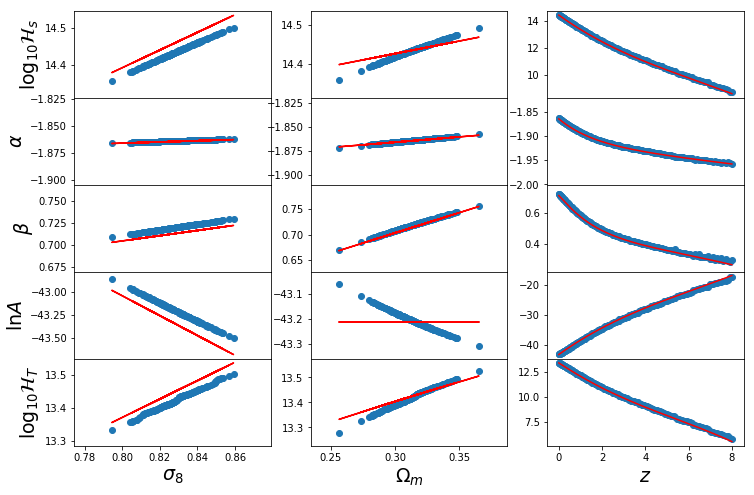Determine relationship of MRP parameters to physical ones¶
In [1]:
%matplotlib inline
import matplotlib.pyplot as plt
import numpy as np
from hmf import MassFunction
from scipy.integrate import simps
from scipy.interpolate import InterpolatedUnivariateSpline as spline
from mrpy.fitting.fit_curve import get_fit_curve
from mrpy import dndm
import os
from astropy.cosmology import Planck13
In [5]:
fig_folder=""
Our goal in this example is to find functions that relate the MRP
parameters, \((\mathcal{H}_s,\alpha,\beta)\) to the physical
parameters \((z,\Omega_m,\sigma_8)\). The results of this analysis
are already stored in the physical_dependence module of mrpy.
This example shows how those models were derived explicitly, and also
gives some ideas on how to fit theoretical curves, and the issues that
can pop up.
Figures from this example appear in MRP (2018) as figures 5,6 and 7
Our first task is to set up the fiducial cosmology and choose a fitting function. We choose the Behroozi+13 SO fitting function, with a fiducial cosmology of Planck+13 (Planck+WP 68% limits):
In [18]:
h = MassFunction(cosmo_model=Planck13, hmf_model = "Behroozi",
dlnk=0.02, lnk_max=11, lnk_min=-6.5, dlog10m=0.01)
Checking Transfer model and Resolution Parameters¶
Before we begin our actual analysis, we need to make sure of a few things concerning the models and resolution. Firstly, we want to make sure that using EH isn’t a big deal. What we do is plot the resulting mass function ratio of an EH vs CAMB model, for several redshifts (dependence on other parameters will be very small), where the mass is scaled by the log mass mode:
In [2]:
def get_mass_mode(m,dndm,scalar=True):
spl = spline(np.log10(m[dndm>0]),(m**2*dndm)[dndm>0],k=4) #k=4 necessary for getting roots next
d = spl.derivative()
if scalar:
return d.roots()[0]
else:
return d.roots()
The mass mode will not change significantly over \(\Omega_m\) or \(\sigma_8\), but will change a lot for redshift. Let’s have a look at this dependence, to make sure everything is okay:
In [19]:
fig,ax = plt.subplots(1,2,figsize=(10,5))
h.update(Mmin=3,Mmax=15)
Z = np.linspace(0,8,25)
mode = np.zeros(len(Z))
for i,z in enumerate(Z):
h.update(z=z)
mode[i] = get_mass_mode(h.m,h.dndm)
ax[0].plot(h.m,h.m**2 * h.dndm,color="k")
ax[0].set_xscale('log')
ax[1].plot(Z,mode,lw=2)
ax[1].plot(Z,13 - 0.9*Z)
ax[1].set_xlabel("Redshift",fontsize=16)
ax[0].set_xlabel("Mass",fontsize=16)
ax[1].set_ylabel("Log Mass Mode",fontsize=16)
ax[0].set_ylabel(r"$m^2 dn/dm$",fontsize=16)
Out[19]:
<matplotlib.text.Text at 0x7f2a5e564e90>
This all looks good (which means that the default resolution parameters are all good for our purposes, but we’ll check this more thoroughly soon). Furthermore, we should be able to define a more efficient function which doesn’t need to have a huge range of Mmin/Mmax:
In [3]:
def get_mass_mode_h(h,Mmin=-3,Mmax=2):
estimate = 13 - 0.9*h.z
finished = False
i = 0
while not finished and i<4:
i += 1
h.update(Mmin=estimate+1.5*Mmin*i**0.5,Mmax=estimate+1.5*Mmax*i**0.5)
mode = get_mass_mode(h.M,h.dndm,scalar=False)
if len(mode)==1 and mode[0]+Mmin > h.Mmin and mode[0]+Mmax < h.Mmax:
finished = True
else:
continue
return mode[0]
Just for testing, let’s use this function to again produce a similar plot to above.
In [21]:
def get_mass_mode_h(h):
return np.log10(h.M[np.argmax(h.m*h.dndlnm)])
Z = np.linspace(0,8,25)
mode = np.zeros(len(Z))
for i,z in enumerate(Z):
h.update(z=z)
mode[i] = get_mass_mode(h.m,h.dndm)
plt.plot(Z,mode,lw=2)
plt.xlabel("Redshift",fontsize=16)
plt.ylabel("Log Mass Mode",fontsize=16)
if fig_folder:
plt.savefig(join(fig_folder,"log_mass_mode.pdf"))
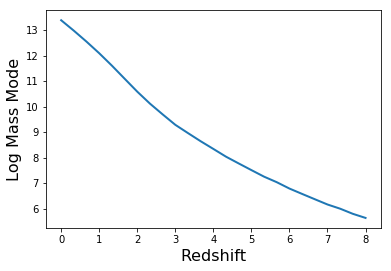
In [4]:
def recast_dndm(m,dndm,mode,Mmin=-3,Mmax=2,dm=h.dlog10m):
mvec = np.arange(mode+Mmin,mode+Mmax,dm)
sp = spline(np.log10(m[dndm>0]),np.log10(dndm[dndm>0]))
return 10**sp(mvec)
---------------------------------------------------------------------------
NameError Traceback (most recent call last)
<ipython-input-4-b9afd81f536a> in <module>()
----> 1 def recast_dndm(m,dndm,mode,Mmin=-3,Mmax=2,dm=h.dlog10m):
2 mvec = np.arange(mode+Mmin,mode+Mmax,dm)
3 sp = spline(np.log10(m[dndm>0]),np.log10(dndm[dndm>0]))
4 return 10**sp(mvec)
NameError: name 'h' is not defined
Mmin and Mmax Determination¶
We want to choose good mass limits for each parameter set. We do this by setting a constant Mmin and Mmax w.r.t. the mass mode. By setting the mode inside these limits, we ensure a good range to define \(\beta\) in each case. Let’s have a look at the mass functions inside these limits:
In [ ]:
h.update(Mmin=-1,Mmax=18)
fig,ax = plt.subplots(2,1,sharex=True,figsize=(8,6),gridspec_kw={"hspace":0})
for z in np.linspace(0,8,9):
h.update(z=z)
mode = get_mass_mode(h.m,h.dndm)
sp = spline(np.log10(h.m[h.dndm>0]),np.log10(h.dndm[h.dndm>0]))
mvec = np.arange(mode-4,mode+4,0.02)
hvec = np.arange(-4,4,0.02)
# The following is necessary since sometimes the vectors have 1 more element
N = min(len(mvec),len(hvec))
mvec = mvec[:N]
hvec = hvec[:N]
ax[0].plot(hvec,10**sp(mvec),lw=2)
ax[1].plot(hvec,10**(2*mvec) * 10**sp(mvec),lw=2)
ax[0].set_yscale('log')
ax[0].set_ylim((1e-40,1e14))
ax[1].set_xlabel(r"$\log_{10} (m/\mathcal{H}_T)$",fontsize=20)
ax[0].set_ylabel(r"$dn/dm$",fontsize=20)
ax[1].set_ylabel(r"$m^2 \frac{dn}{dm}$",fontsize=20)
h.update(z=0)
In [ ]:
Mmin = -3
Mmax = 2
Data Generation¶
The main idea is to generate a sample of parameters, \((z,\Omega_m,\sigma_8)\), based on a realistic distribution (i.e. Planck13), then for each parameter, generate the HMF between the relevant limits. Then each HMF is to be fit with the MRP. The resulting parameters will need to be fit in Eureqa, after which we’ll port the results back here ;)
So, first up, the general parameters of the samples:
Parameter Samples¶
In [ ]:
# General configuration for parameter samples
N_1d = 200 # Number of samples to draw for 1D data
N_3d = 2000 # Number of samples to draw for 3D data
s8_mean = h.sigma_8
s8_sd = 0.012
Om0_mean = h.cosmo.Om0
Om0_sd = 0.017
Both \(\sigma_8\) and \(\Omega_m\) will be sampled from the Planck distribution, but \(z\) will come from a log-linear distribution (which more highly weights low redshifts, but not too much). First, define a function which will generate the samples:
In [ ]:
def get_parameter_sample(N, zbound,s8_mean=s8_mean,s8_sd=s8_sd,Om0_mean=Om0_mean,Om0_sd=Om0_sd):
sigma_8 = np.random.normal(s8_mean, s8_sd, size=N)
Om0 = np.random.normal(Om0_mean, Om0_sd, size=N)
if not hasattr(zbound, "__len__"):
z = np.repeat(zbound, N)
else:
z = np.exp(np.linspace(np.log(1 + zbound[0]), np.log(1 + zbound[1]), N)) - 1
return sigma_8, Om0, z
And a function which generates the EPS mass function from each sample.
In [ ]:
def get_hmfs(h, Om0, z, s8,Mmin=-3,Mmax=1):
# If Om0 is a scalar, then things can be sped up a bit.
try:
Om0[3]
go_for_it = False
except:
go_for_it = True
# Make sure they're all vectors
Om0 = np.atleast_1d(Om0)
z = np.atleast_1d(z)
s8 = np.atleast_1d(s8)
N = max(len(Om0),len(z),len(s8))
if len(Om0)==1: Om0 = np.repeat(Om0,N)
if len(s8)==1: s8 = np.repeat(s8,N)
if len(z)==1: z = np.repeat(z,N)
Nm = len(arange(Mmin,Mmax,h.dlog10m))
dndm = np.zeros((Nm,N))
mode = np.zeros(N)
h.update(Mmin=2,Mmax=16)
for i, (s, zz, m) in enumerate(zip(s8, z, Om0)):
if i%100==0:
print float(i) * 100 / float(len(z)), "% done"
h.update(cosmo_params={"Om0":m}, z=zz, sigma_8=s)
if go_for_it:
mode[i] = get_mass_mode(h.M,h.dndm)
else:
mode[i] = get_mass_mode_h(h)
#get vals at new mass range
dndm[:,i] = recast_dndm(h.m,h.dndm,mode[i],Mmin=Mmin,Mmax=Mmax,dm=h.dlog10m)[:Nm]
new_m = arange(mode[i]+Mmin,mode[i]+Mmax,h.dlog10m)
# for some reason, sometimes new_m is 1 bigger than needed
if len(new_m)>Nm:
new_m = new_m[:Nm]
return dndm,mode
Now, try to read the samples in from a data file, otherwise produce them again.
In [ ]:
if os.path.exists("phys_dep/raw_data.npz"):
all_data = np.load("phys_dep/raw_data.npz")
# 3d
s8_3d = all_data["s8_3d"]
Om0_3d = all_data["Om0_3d"]
z_3d = all_data["z_3d"]
dndm_3d = all_data["dndm_3d"]
Ht_3d = all_data["Ht_3d"]
# 1d
s8_1d = all_data["s8_1d"]
Om0_1d = all_data["Om0_1d"]
z_1d = all_data["z_1d"]
dndm_z_1d = all_data['dndm_z_1d']
dndm_s8_1d = all_data['dndm_s8_1d']
dndm_Om0_1d = all_data['dndm_Om0_1d']
Ht_z_1d = all_data['Ht_z_1d']
Ht_s8_1d = all_data['Ht_s8_1d']
Ht_Om0_1d = all_data['Ht_Om0_1d']
del all_data
else:
# Create Samples
s8_1d, Om0_1d, z_1d = get_parameter_sample(N_1d,(0,8))
s8_3d, Om0_3d, z_3d = get_parameter_sample(N_3d,(0,8))
# Calculate HMF's
dndm_s8_1d, Ht_s8_1d = get_hmfs(h,Om0,0,s8_1d,Mmin=Mmin,Mmax=Mmax)
dndm_Om0_1d, Ht_Om0_1d = get_hmfs(h,Om0_1d,0,s8,Mmin=Mmin,Mmax=Mmax)
dndm_z_1d, Ht_z_1d = get_hmfs(h,Om0,z_1d,s8,Mmin=Mmin,Mmax=Mmax)
print "done 1d z"
dndm_3d, Ht_3d = get_hmfs(h,Om0_3d,z_3d,s8_3d,Mmin=Mmin,Mmax=Mmax)
print "done 3d 8"
For good measure, check the distributions:
In [33]:
fig,ax = plt.subplots(1,3,figsize=(12,3))
ax[0].hist(s8_1d,normed=True,bins=20)
ax[1].hist(Om0_1d,normed=True,bins=20)
ax[0].hist(s8_3d,normed=True,bins=20)
ax[1].hist(Om0_3d,normed=True,bins=20)
ax[2].hist(z_1d,normed=True,bins=20)
ax[2].hist(z_3d,normed=True,bins=20)
ax[0].set_xlabel(r"$\sigma_8$")
ax[1].set_xlabel(r"$\Omega_m$")
ax[2].set_xlabel(r"$z$")
Out[33]:
<matplotlib.text.Text at 0x7f2a5c108090>

To me, it looks like the best choice will be something like (-3,2). This will give an upper limit of about 15.5 at z=0, which is pretty close to the largest things we expect to find.At high redshift, this will reach down to \(M_{\rm min} \approx 3\), which is incredibly small, but hey, who trusts these scales anyway?
Now save the data for use next time…
In [53]:
np.savez("phys_dep/raw_data.npz",s8_3d=s8_3d,Om0_3d=Om0_3d,z_3d=z_3d,dndm_3d=dndm_3d,Ht_3d=Ht_3d,
z_1d=z_1d,dndm_z_1d=dndm_z_1d,Ht_z_1d=Ht_z_1d,
s8_1d = s8_1d,dndm_s8_1d=dndm_s8_1d,Ht_s8_1d=Ht_s8_1d,
Om0_1d = Om0_1d,dndm_Om0_1d=dndm_Om0_1d,Ht_Om0_1d=Ht_Om0_1d)
Now it would be good to have a look at all the fits to make sure they look reasonable.
In [34]:
def plot_sample(sample,m,ax=None,ratio=False,color="k",alpha=0.3,label=None,**kwargs):
if ax is None:
ax = plt.subplot(111)
for i in range(sample.shape[1]):
if i>0:
label=None
if ratio:
ax.plot(m,sample[:,i]/sample[:,0],color=color,alpha=alpha,label=label**kwargs)
else:
ax.plot(m,sample[:,i],color=color,alpha=alpha,label=label,**kwargs)
First look at all the 1d distros
In [35]:
mvec = np.arange(Mmin,Mmax,h.dlog10m)
fig,ax=plt.subplots(3,1,sharex=True,gridspec_kw={"hspace":0.0},subplot_kw={"yscale":'log'},figsize=(8,6))
for i,sample in enumerate([dndm_s8_1d,dndm_Om0_1d,dndm_z_1d]):
plot_sample(sample,mvec,ax[i],ratio=False)
ax[2].set_xlabel(r"$\log_{10}(m/\mathcal{H}_T)$",fontsize=20)
ax[1].set_ylabel(r"$dn/dm$",fontsize=24)
ax[0].text(1,1e-13,r"$\sigma_8, z=0$",fontsize=16)
ax[1].text(1,1e-13,r"$\Omega_m, z=0$",fontsize=16)
ax[2].text(1,1e-2,r"$z$",fontsize=16)
Out[35]:
<matplotlib.text.Text at 0x7f2a3ebd5610>
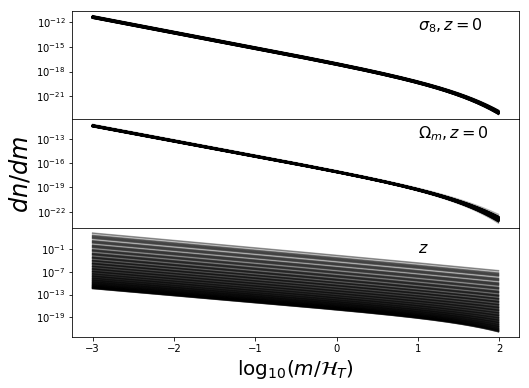
These look nice and contiguous as we would expect. Now the 3d distros:
In [36]:
mvec = np.arange(Mmin,Mmax,h.dlog10m)
plot_sample(dndm_3d,mvec,ratio=False)
plt.xlabel(r"$\log_{10}(m/\mathcal{H}_T)$",fontsize=20)
plt.ylabel(r"$dn/dm$",fontsize=24)
plt.text(1,1e-13,r"$z=0$",fontsize=16)
plt.text(1,1e0,r"$z=(0,8)$",fontsize=16)
plt.yscale('log')
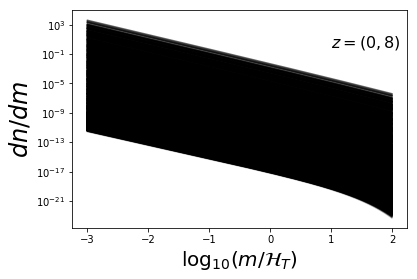
Fit MRP¶
First we define a generic function that will fit the dndm vectors.
In [ ]:
def fit_all_mrp(sample,mode,Om0=None,Mmin=-3,Mmax=1,s=0):
par = np.zeros((sample.shape[1],4))
fit = np.zeros_like(sample)
if Om0 is None:
Om0 = np.zeros(sample.shape[1])
guesstimate = [14.5,-1.9,0.8,-40]
for i,(dndm,m) in enumerate(zip(sample.T,mode)):
M = 10**np.arange(m+Mmin,m+Mmax,h.dlog10m)[:len(dndm)]
res,curve = fit_curve(M,dndm,hs0=guesstimate[0],alpha0=guesstimate[1],
beta0=guesstimate[2],lnA0=guesstimate[3])
par[i] = res.x
fit[:,i] = curve.dndm()
guesstimate = par[i]
return par,fit
And now a couple of functions which plot the results:
In [ ]:
def plot_mrp_fit(fit_dict,ax=None,Mmin=Mmin,Mmax=Mmax,dm=h.dlog10m):
if ax is None:
ax = plt.subplot(111)
mvec = np.arange(Mmin,Mmax,dm)[:dndm_3d.shape[0]]
for i in range(dndm_3d.shape[1]):
ax.plot(mvec,fit_dict["fit_3d"][:,i]/dndm_3d[:,i],color="k",alpha=0.2)
def plot_mrp_param_dep(fit_dict):
fig,ax=plt.subplots(5,3,sharex="col",gridspec_kw={"hspace":0},figsize=(12,8))
for i in range(5):
if i<4:
ax[i,0].scatter(s8_1d,fit_dict['par_s8_1d'][:,i])
else:
ax[i,0].scatter(s8_1d,Ht_s8_1d)
ax[i,0].set_ylabel([r"$\mathcal{H}_s$",r"$\alpha$",r"$\beta$",r"$\log A$",r"$\mathcal{H}_T$"][i],fontsize=16)
for i in range(5):
if i<4:
ax[i,1].scatter(Om0_1d,fit_dict['par_Om0_1d'][:,i])
else:
ax[i,1].scatter(Om0_1d,Ht_Om0_1d)
for i in range(5):
if i<4:
ax[i,2].plot(z_1d,fit_dict['par_z_1d'][:,i])
else:
ax[i,2].plot(z_1d,Ht_z_1d)
for i in range(3):
ax[3,i].set_xlabel([r"$\sigma_8$",r"$\Omega_m$",r"$z$"][i],fontsize=16)
Here we generate the data (again, only if not found in a corresponding file already):
In [39]:
if os.path.exists('phys_dep/fits.npz'):
fits = dict(np.load("phys_dep/fits.npz"))
else:
fits = {}
fits["par_s8_1d"], fits["fit_s8_1d"] = fit_all_mrp(dndm_s8_1d , Ht_s8_1d, Mmin=Mmin,Mmax=Mmax)
fits["par_Om0_1d"],fits["fit_Om0_1d"] = fit_all_mrp(dndm_Om0_1d, Ht_Om0_1d,Mmin=Mmin,Mmax=Mmax)
fits["par_z_1d"], fits["fit_z_1d"] = fit_all_mrp(dndm_z_1d , Ht_z_1d, Mmin=Mmin,Mmax=Mmax)
fits["par_3d"], fits["fit_3d"] = fit_all_mrp(dndm_3d , Ht_3d, Mmin=Mmin,Mmax=Mmax)
np.savez("phys_dep/fits.npz",**fits)
np.savetxt("phys_dep/s8_fits.dat",np.vstack((s8_1d,fits['par_s8_1d'].T)).T)
np.savetxt("phys_dep/Om0_fits.dat",np.vstack((Om0_1d,fits['par_Om0_1d'].T)).T)
np.savetxt("phys_dep/z_fits.dat",np.vstack((z_1d,fits['par_z_1d'].T)).T)
np.savetxt("phys_dep/3d_fits.dat",np.vstack((s8_3d,Om0_3d,z_3d,fits['par_3d'].T)).T)
Now plot the resulting functions.
In [40]:
plot_mrp_fit(fits)
plot_mrp_param_dep(fits)
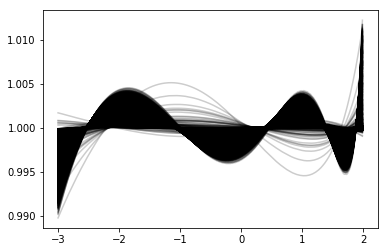
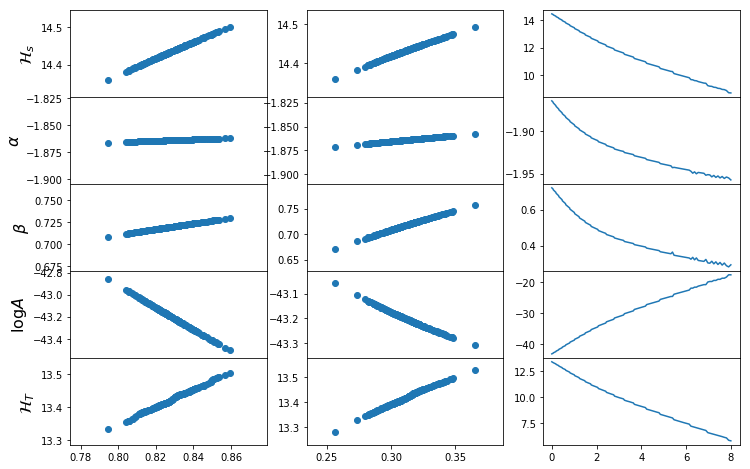
Return from Eureqa¶
The data we generated was input to the program “Eureqa” to determine
relationships between the physical and MRP parameters. The results were
then implemented in physical_dependence.
Get new fits for all the data¶
First, we define a helper function for putting labels above entire rows/columns of axes:
In [ ]:
def suplabel(axis,label,label_prop=None,
labelpad=5,
ha='center',va='center'):
''' Add super ylabel or xlabel to the figure
Similar to matplotlib.suptitle
axis - string: "x" or "y"
label - string
label_prop - keyword dictionary for Text
labelpad - padding from the axis (default: 5)
ha - horizontal alignment (default: "center")
va - vertical alignment (default: "center")
'''
fig = plt.gcf()
xmin = []
ymin = []
for ax in fig.axes:
xmin.append(ax.get_position().xmin)
ymin.append(ax.get_position().ymin)
xmin,ymin = min(xmin),min(ymin)
dpi = fig.dpi
if axis.lower() == "y":
rotation=90.
x = xmin-float(labelpad)/dpi
y = 0.5
elif axis.lower() == 'x':
rotation = 0.
x = 0.5
y = ymin - float(labelpad)/dpi
else:
raise Exception("Unexpected axis: x or y")
if label_prop is None:
label_prop = dict()
plt.text(x,y,label,rotation=rotation,
transform=fig.transFigure,
ha=ha,va=va,
**label_prop)
We basically run through all our samples, generating fits for them based on the parameterisations we created, then we plot each as a ratio to the true HMF. For some more clarity, we do this in several redshift bins.
In [43]:
# Import the necessary function
from mrpy.extra.physical_dependence import mrp_b13, _alpha_b13, _beta_b13, _logHs_b13, _lnA_b13
# Define each mass function based on our results
post_fit = np.zeros_like(dndm_3d)
for i,(z,m,s,mode) in enumerate(zip(z_3d,Om0_3d,s8_3d,Ht_3d)):
mvec = 10**np.arange(mode+Mmin,mode+Mmax,h.dlog10m)[:len(dndm_3d)]
post_fit[:,i] = mrp_b13(mvec,z,m,s)
# Create a figure plotting the average ratio of the functions
# to the true HMF, with shading giving the uncertainty region.
ratio = post_fit/dndm_3d
hvec = np.arange(Mmin,Mmax,0.01)[:len(mvec)]
cols = ["b","g","r","c"]
fig,ax = plt.subplots(2,2,sharey=True,sharex="col",figsize=(7,5),gridspec_kw={"hspace":0,"wspace":0},
subplot_kw={"ylim":(0.93,1.09),"xlim":(-3.1,2.2)})
for j,zrange in enumerate([(0,1),(1,3),(3,6),(6,8)]):
mask = np.logical_and(z_3d>=zrange[0], z_3d < zrange[-1])
mean = np.median(ratio[:,mask],axis=1)
qlow, qhi = np.percentile(ratio[:,mask],(16,84),axis=1)
ax[divmod(j,2)].plot(hvec,mean,lw=2,color=cols[j],label="z=(%s,%s)"%zrange)
ax[divmod(j,2)].fill_between(hvec,qlow,qhi,color=cols[j],alpha=0.3)
ax[divmod(j,2)].text(-2.5,1.04,"z=(%s,%s)"%zrange,fontsize=15)
ax[divmod(j,2)].tick_params(axis='both', which='major', labelsize=13)
if j==2:
ax[divmod(j,2)].xaxis.set_ticks([-3,-2,-1,0,1])
suplabel('x',r"$\log_{10}(m/\mathcal{H}_T)$",label_prop={"fontsize":15},labelpad=7)
suplabel("y","MRP/Behroozi",label_prop={"fontsize":15},labelpad=6)
# Save for the paper!
if fig_folder:
plt.savefig(fig_folder+"param_3d.pdf")
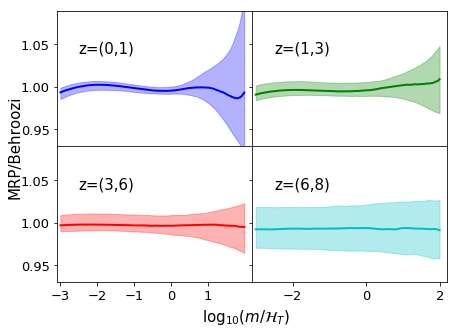
Also, we can re-look at the parameter dependence with included parameterisations:
In [45]:
fig,ax=plt.subplots(5,3,sharex="col",gridspec_kw={"hspace":0},figsize=(12,8))
Om0 = h.cosmo.Om0
s8 = h.sigma_8
## Dependence on s8
Hs = _logHs_b13(0,Om0,s8_1d)
alpha = _alpha_b13(0,Om0,s8_1d)
beta = _beta_b13(0,Om0,s8_1d)
lnA = _lnA_b13(0,Om0,s8_1d)
param = [Hs,alpha,beta,lnA]
for i in range(5):
if i<4:
ax[i,0].scatter(s8_1d,fits['par_s8_1d'][:,i])
ax[i,0].plot(s8_1d,param[i],color="r")
else:
ax[i,0].scatter(s8_1d,Ht_s8_1d)
ax[i,0].plot(s8_1d,Hs+np.log10((alpha+2)/beta)/beta,color="r")
ax[i,0].set_ylabel([r"$\log_{10}\mathcal{H}_s$",r"$\alpha$",r"$\beta$",r"$\ln A$",r"$\log_{10}\mathcal{H}_T$"][i],fontsize=19)
## Dependence on Om0
Hs = _logHs_b13(0,Om0_1d,s8)
alpha = _alpha_b13(0,Om0_1d,s8)
beta = _beta_b13(0,Om0_1d,s8)
lnA = _lnA_b13(0,Om0_1d,s8)
param = [Hs,alpha,beta,lnA]
for i in range(5):
if i<4:
ax[i,1].scatter(Om0_1d,fits['par_Om0_1d'][:,i])
ax[i,1].plot(Om0_1d,param[i],color="r")
else:
ax[i,1].scatter(Om0_1d,Ht_Om0_1d)
ax[i,1].plot(Om0_1d,Hs+np.log10((alpha+2)/beta)/beta,color="r")
## Dependence on z
Hs = _logHs_b13(z_1d,Om0,s8)
alpha = _alpha_b13(z_1d,Om0,s8)
beta = _beta_b13(z_1d,Om0,s8)
lnA = _lnA_b13(z_1d,Om0,s8)
param = [Hs,alpha,beta,lnA]
for i in range(5):
if i<4:
ax[i,2].scatter(z_1d,fits['par_z_1d'][:,i])
ax[i,2].plot(z_1d,param[i],color="r")
else:
ax[i,2].scatter(z_1d,Ht_z_1d)
ax[i,2].plot(z_1d,Hs+np.log10((alpha+2)/beta)/beta,color="r")
for i in range(3):
ax[4,i].set_xlabel([r"$\sigma_8$",r"$\Omega_m$",r"$z$"][i],fontsize=19)
for i in range(5):
for j in range(3):
yticks = ax[i,j].yaxis.get_major_ticks()
yticks[0].label1.set_visible(False)
yticks[-1].label1.set_visible(False)
# Save for the paper!
if fig_folder:
plt.savefig(fig_folder+"param_dep.pdf")
